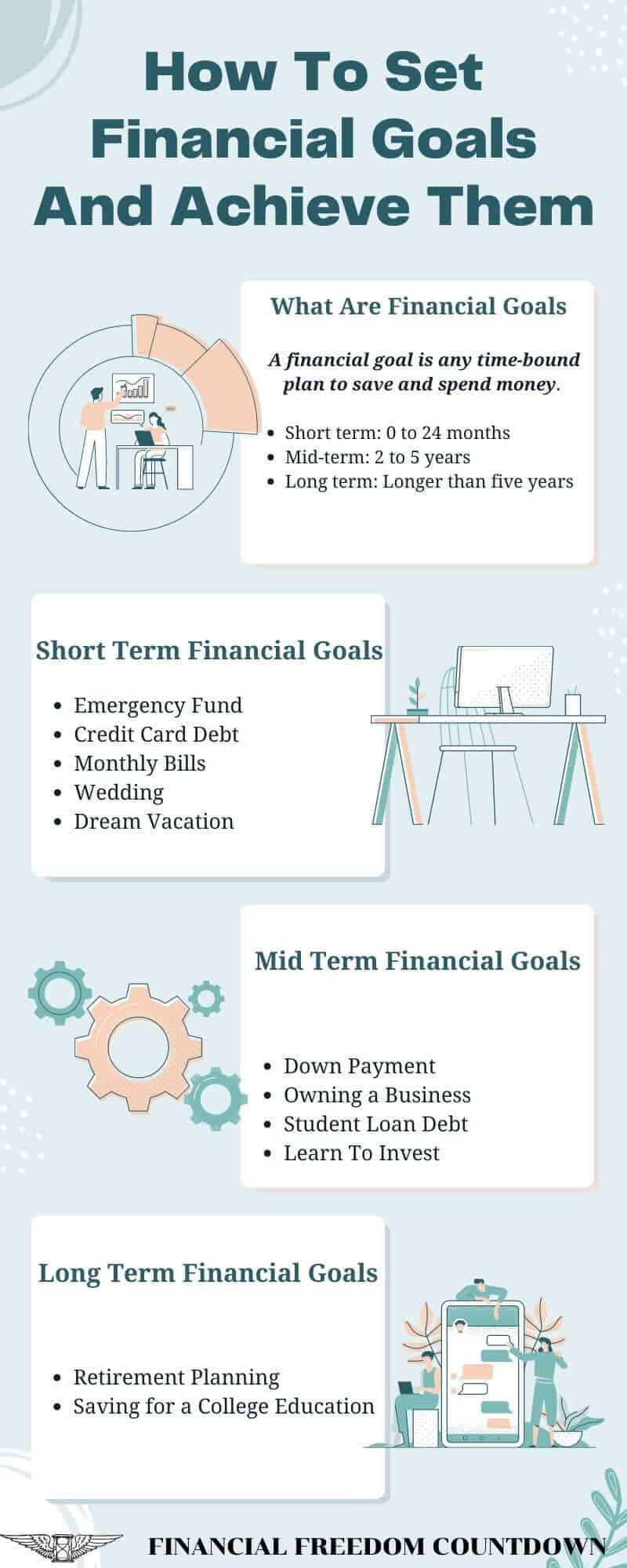How To Set Financial Goals and Achieve Them: Step-by-Step Guide

It can be tough to figure out how to get your finances in order. You’re not alone – most people have a lot of trouble with this.
You probably know that you should be investing and saving for the future, but it can be tough to get started.
Financial goals can help you stay on track. By setting simple, achievable goals, you can make sure that you’re making progress towards a more secure future. Knowing precisely what you want to achieve financially and in what time frame helps a person stick to those goals.
Of course, it is much easier said than done. But by knowing what the goals are, you can accomplish them. With the right financial decisions and proper financial planning, you can reach all financial goals.
What Are Financial Goals?
A financial goal is any time-bound plan to save and spend money. It can be short-term financial goals, long-term financial goals, and everything in between.
A short-term goal could be as simple as saving $1,000 in six months.
A long-term goal could be something like planning for retirement. There are many reasons for having a financial goal. If a person wants something bad enough, the best way to get that is to have financial goals. And most people have several financial goals at the same time.
How To Set Financial Goals
Just telling yourself that you want to save money for a vacation or a new car is usually never good enough. It is best to write down financial goals and keep those goals in plain sight. When someone writes down their goals, they are more likely to achieve them.
A financial goal has to be specific. Writing down that you want to save more of your paycheck or retire as a millionaire rarely works. A plan needs to be spelled out. If someone wants to take a vacation in one year, the goal needs to specifically say that I want to save $1,000 for a holiday next year.
The financial goal also needs to be measurable. You should know how close you are to achieving it. If your financial goal is to build a $1000 emergency fund in 6 months, and after two months, you have $500, you can measure that you completed 50% of your goal.
A goal needs some deadline. For example, a person wants to pay off credit card debt in a certain amount of time. When the goal is set, it is time to pick the timeframe and the amount. After looking at your budget and how much you need to pay off, you decide how much you want to pay each month and when that amount will meet your timeframe. That is a measurable goal.
Once the deadline or timeframe has been decided, do the math. When you do the math will help you decide on the amount to pay each month. The goal has to be reasonable. Do not make the goal too lofty or unreasonable. If the goal is outrageous and you don’t hit the plan each month, it is easy to say forget this goal. Financial goals should have the characteristics of SMART goals:
- Specific (no room for ambiguity in interpretation)
- Measurable (to track progress)
- Attainable (should be challenging but achievable)
- Relevant (to your situation)
- Time-specific (have a deadline)
Any financial goal a person makes should be their own goal. Never make a goal that fits other people’s dreams. It has to be the best choice for the individual. Make them personal goals.
If it seems everyone is taking out a second mortgage just to take a vacation or buy a new car, don’t think that is for you. Do not compare yourself or your financial goals with other people. That is a game you will probably never win.
A personal goal is your own goal, not your neighbors or coworkers. When you make your own goals, you do it for yourself, not them. It becomes a personal challenge, and a person is more likely to stick to a plan when it becomes personal than if it is just keeping up with the neighbors.
For example, you may have a goal to pay off your mortgage in 5 years. Others may say it is not a wise goal since the money can be invested to earn a higher return. But at the end of the day, it is your goal and your peace of mind at owning your home free and clear is more important than any number on a spreadsheet.
Benefits of Setting a Financial Goal
A benefit of setting a financial goal or goals is seeing progress or lack of progress. A written goal is a plan that needs to be adhered to. We should also write down how we are progressing or falling behind each week or month by looking at our written goals.
A goal tells us what we want to achieve, and a financial plan tells us how.
If we start to fall behind on our financial plan, we can see this and make small changes to get back on track. If we are on our way, it will undoubtedly give us the motivation to continue. If we fall too far behind in our goal, we might realize it was unrealistic, to begin with and need to come up with a more reasonable financial goal.
Common Financial Goals Examples
When we start to develop financial goals and write them out, it can seem like a daunting task. We want to achieve so many financial goals, and we might decide it is just too hard to do. Here are some common financial goals based on personal finance basics that most people try to achieve:
- Build an emergency fund
- Get out of debt
- Save for retirement
- Save for college
- Save for a home
Having a specific goal and a specific time frame in mind can help keep us focused on the plan. If we become unfocused, we could start throwing money at other things that deter us from attaining our goals. Another way to look at goals is to divide them by time frame.
Three Types of Financial Goals
The three types of financial goals are
- Short term financial goals: 0 to 24 months
- Mid-term goals: 2 to 5 years
- Long term financial goals: Longer than five years
Short Term Financial Goals
Short-term financial goals would include:
- Saving for an emergency fund.
- Paying down debt.
- Saving for something you want soon.
Emergency Fund
Before someone starts saving for a new car, vacation, or retirement, they should build an emergency fund first. With an emergency fund, you can focus on the other goals with more peace of mind. When we start making financial goals and funding those goals, life always gets in the way. And those things in life can quickly derail a financial goal unless you have the financial resources to weather an emergency.
Once we have accomplished this first financial goal, we can set our sights on other goals with more extended time frames. An emergency fund is only for emergencies and should not be used for other things.
Emergencies might include the loss of a job, car repairs, medical expenses, or other things that need immediate attention. Most advisors say we need three to six months of living expenses to save in an emergency fund. It should cover rent or mortgage payments, car payments, food, utilities, and other monthly debts.
An emergency fund can be kept in a savings account, certificates of deposit, or other safe savings accounts. The one thing about savings accounts is that they are easily accessible, which might tempt someone to use that money when they shouldn’t.
Credit Card Debt
Paying off your credit card balance is a worthy use of your money and can help you save more in the future. You might have started that credit card debt with a 0% interest card for some time, but you will pay 16% or higher on the balance after the introductory period expires.
That kind of interest adds up quickly, and the sooner you pay off that credit card debt, the sooner you can put that money to better use.
Since credit card debt is a very high-interest rate, it is best to pay it down as soon as possible. If you have been paying higher interest on credit cards, check out individual loan rates from around ten vetted lenders in 2 minutes on Credible.
Use the Personal Loan only to eliminate your higher interest rate debt and not take on additional debt.
Being debt-free saves more money than most people realize. Personal finance and financial literacy will help everyone avoid credit card debt. When you get rid of credit card debt and other debts that carry interest, you are making money by saving what you would have to continue to pay on the interest. Besides, being debt-free also has enormous psychological benefits.
Monthly Bills
A simple short-term goal is paying the monthly bills like rent, car payments, and insurance. Making sure you stick to this goal and paying these items off on time will help you build more confidence about setting long-term goals.
Having a budget template will help with your financial goal of monthly bills. Budgeting does not have to be complicated. A simple 50-30-20 rule can help you get started.
Or you can use Personal Capital, free software which combines your cash flow, budgets, credit cards, bills, and investment tracking in one place and makes it easy to manage. It automatically updates and classifies your financial data to know where you’re at financially. Unlike other budgeting apps, Personal Capital doesn’t need you to do the tedious task of setting up a budget. After you link all your accounts together, it looks at your current spending and creates a budget for your lifestyle. You can then modify it as needed. You can read my Personal Capital Review on how I use the various components and set up your free account.
Wedding
Maybe you are planning a wedding within a year or two. Setting a financial goal for the wedding is smart planning. Figure out how much you will need to speed ahead of time and create a realistic budget for the wedding. Once you have a budget, write out the goal and start saving for it.
Dream Vacation
You might have a planned vacation you want to take in a year, and you need to prepare for it. Now is the best time to start a goal towards that. Other short-term goals would include any other type of personal items you would like to have within the next two years.
Mid Term Financial Goals
These goals would include anything you plan for the next two to five years. This goal is personal to a person’s wants and desires for the near future and could be dependent on age.
Sometimes a short-term financial goal can turn into a mid-term goal. Other factors would include financial situation, current income, how much debt they currently have, and whether or not they have multiple income streams, like a second job or a spouse who contributes to the financial goals.
It is not uncommon to have goals that overlap from one category to another category. Do not get caught up in the time frame, and always concentrate on sticking to your plan of saving money.
Down Payment
Saving for a new home is one of the most common goals for the mid-term. If someone wants to save for a down payment, they would first decide how much of a down payment they want to make. It might be anywhere from 5% to as much as 20%. After all, real estate is one of the most stable asset classes with a decent risk/reward ratio. Run your numbers and decide is now a good time to buy a house?
After researching the housing markets in their city or the city they want to move to in the future, they will have a good idea of how much to save. If the homes they look at cost around $500,000, a realistic goal would be to save $25,000 for a 5% down payment. First-time homebuyers can take advantage of FHA loans.
Owning a Business
Buying your own business is another mid-term goal since many people are dissatisfied with working for someone else. When you own a business, you are the boss, and a business owner will make more money than if they worked for someone else.
Our analysis of average net worth by age broken down by employment status indicates a wide gap between business owners and employees. There are always businesses for sale and franchise opportunities. Before someone can buy a business, they have to have the money saved up. It is another worthwhile mid-term goal.
If you want a more straightforward way to own a business, you could start a website.
Your website could be related to your day job. Or you could create one talking about your hobbies. Given the digital economy, no matter which path you pick, more and more of our world will be moving online. Automated tools make it easy to start a website in 10 minutes with zero computer programing skills. Here is my Bluehost affiliate link to get started with a monthly cost of only $2.95.
Student Loan Debt
You will free up your budget for other goals by paying off your student loan debt within five years. Student loans can become a burden for many just out of college and stop us from achieving other monetary goals.
Paying off the student loan debt depends on the jobs available in the field a graduate has a degree in and the overall job market. But like other worthy financial goals, getting rid of student loans will allow you to start saving for new goals.
Income-based repayment plans will reduce the strain on your budget. However, a private lender might impose a different payment schedule.
Look at options like Credible for Student Loan Refinancing. Why pay higher interest rates when you could lower your payments by refinancing federal, private, and ParentPLUS loans? Checking rates won’t affect your credit score.
Learn To Invest
In addition to an emergency fund, it’s also essential that we include investing for our future selves. Investing is one of the topmost personal finance fundamentals that everyone should know. Investing can be a great way to build generational wealth and improve our financial future.
After fully funding our 401(k), look at investing in your brokerage account. If we’re ready to start investing, then we must take the time to learn how it works and what strategies we can use. Learn to invest in real estate or stocks which tend to be the most popular options.
If we choose to invest in stocks, we must research and make wise investments. We can even purchase stock in companies we already know and love, like Disney, Apple, or Amazon. The key to investing in stocks is auto-investing regularly by dollar-cost averaging on a monthly basis and periodically rebalancing. M1 Finance is the platform I use to fund my moonshot stocks, and you can learn more in my M1 Finance Review.
If you have sufficient funds and enjoy being a landlord, learn how to evaluate a rental property. There are several ways to invest in real estate with little or no money.
Make sure you buy in one of the best states for real estate investors.
If you prefer a more passive income approach to real estate, look into crowdfunding real estate. Some of the crowdfunded platforms require you to meet accredited investor qualifications.
Fundrise and Diversify are available to all investors, including non-accredited investors, and offer low minimums of $10 and $500, respectively, to get you started investing in real estate.
Both stocks and real estate can be risky, so it’s essential to understand the risks involved before investing our hard-earned money. No matter what we choose to do with our money, it’s important to remember that patience is vital.
Investments can take time to grow, so be prepared to wait a while before you see any significant returns.
Long Term Financial Goals
Long-term goals are far-reaching and a little trickier because of not knowing what the future might bring. There are so many variables that can interrupt a long-term financial goal.
If a person sets their sights on realistic long-term goals, has the math correct, and possibly with the help of a financial planner, these goals are not that hard to achieve. Just keep your eyes on the long-term goal.
Retirement Planning
Retirement planning is one of the most popular long-term goals. To answer the “when can I retire” question, you should have a good idea of your retirement goals. Like where you would like to live when you retire and what you would like to do in retirement.
Do you want to move to a mountain resort and ski, or would you like to live by the ocean? Maybe you would like to travel the world or just be able to live a comfortable retirement.
One crucial question to ask yourself is at what age you would like to be able to retire. Although it is possible to retire early at any age, the number of years you spend in retirement will determine how much you need to save every month.
Saving for a College Education
Saving for a child’s college education is another long-term goal and should be started as soon as possible. At first, this goal is vague since no one usually knows what college their kids will attend. But getting the fund started quickly is the key if you want to achieve this goal.

How To Achieve Short and Mid Term Financial Goals
The way to achieve both of these goals is essentially the same. Just that one has a longer time frame.
The best way to achieve your financial goals is by earning more money. You could leverage your human capital to obtain a higher-paying job and increase your income. Or develop passive income streams to augment your current income.
Another approach could be to start saving money. Look for ways you can cut back and analyze your spending habits.
To improve our finances, we must stay away from lifestyle inflation and make an effort to live within our means.
How often do you eat your lunch in a restaurant each week or buy coffee at Starbucks? It’s these little things that add up over time. Don’t rush out and spend your tax refund.
Increase your saving rate using a combination of increased income and reduced expenses
If someone can cut back enough to save $25 per week, they would have an extra $100 per month. That $100 could grow into an account of around $8,000 in just five years when you consider compound interest.
For a person to reach their money goals, they need to put this money into an interest-bearing account, and that is where compounding comes into play. A certified financial planner can help you find the best types of accounts, or you can do the research yourself.
With interest rates so low over the last decade, finding any type of saving account that pays much interest has been challenging. Getting a decent interest rate usually takes investing in bonds or blue-chip stocks in the stock market. With stocks, there is a risk of a falling market. And for those with a short to mid-term goal, losing the principle is not something you should risk.
With inflation running high, one of the best investments for those with mid-term money goals is I-bonds from the United States government. They are paying 9.62% for the next six months.
I-bonds are an almost risk-free investment that pays a great interest rate. They have a variable rate that is pegged to inflation. The monthly rate changes every six months. Anyone who invests in I bonds cannot take the money out of the investment for one year. And there is an early redemption penalty of 3 months if you take the money out within five years.
That is perfect because it pays a higher interest rate, preventing you from taking money out too soon. The one negative with an I-bond is you can only invest $10,000 in these bonds. But for someone with a mid-term goal, they are the perfect place to grow your money. They are sold in denominations of $50, $100, $200, $500 and $1,000.
To achieve a short-term financial goal, budgeting and cutting back on spending are best. Investing in anything other than certificates of deposits (CDs), money market accounts, and savings accounts could be too risky for a loss of principle.
If your money goal setting is for less than two years, the goal-setting process needs to focus on saving money and not risk losing it with any type of investing. Do you really need cable or satellite television for the next year or two? Cutting the cord could save you as much as $100 or more per month. Everyone has something they can cut out to meet a goal setting.
Most companies drain our money by asking us to sign up for subscription services. We often pay for several subscription services and don’t even use them.
Trim is an excellent service that looks at all your current subscriptions and saves money by eliminating unnecessary money leeches. Also, instead of paying full price, see if Trim can do the work negotiating your cable, phone, and internet bills lower.
How To Achieve a Long Term Financial Goal
Anyone can achieve long-term goals. Whether someone works as a janitor, a magazine’s managing editor, or a doctor, financial success is within everyone’s reach. All it takes is a plan, a goal, and the desire to stick to the plan. But realize that long-range goals are not easy because other things in life tend to get in the way.
Planning for retirement is the best example of a long-range goal. With social security not keeping up with inflation and pensions not being fully funded, having a retirement plan of your own is a good idea. The five steps to begin starting with your retirement planning are:
- Begin as soon as you are able
- Calculating how much money you will need when you retire
- Setting priorities and knowing what your top priority is
- Choosing accounts
- Picking the right investments
The general rule is that the younger you are when you start this plan, the more aggressive you can be. If you lose money while investing when you’re young, you will have more time to make up for those losses.
Learn how to invest money and put your salary increases, bonuses, annual tax refund, and extra money into income-producing assets.
As you get closer to retirement age, most people will reduce the amount of money they have invested in stocks and put it into less risky bonds. Instead of choosing individual stocks and bonds, it is much easier and less time-consuming to pick mutual funds, exchange-traded funds, and closed-end funds for your retirement goals.
Also, if bonds are paying a low rate, you could consider bond-like instruments backed by tangible assets. Real estate notes backed by mortgages are one option. Investing in farmland could be another option. Determine your risk profile and invest accordingly since higher return is often co-related with higher risk.
Most financial advisors advocate replacing 70% to 90% of your yearly pre-retirement income through savings and social security. A retiree who earns around $63,000 per year before retirement is expected to need between $44,000 and $57,000 per year in retirement.
The rule of thumb calculation might not be accurate if you have been on the financial literacy path. Instead, you can use various free retirement calculators to estimate your income needed in retirement.
Many will have more than one financial priority at a time. The key is to make one your top priority while not losing sight of your other goals.
Thankfully, there are ways you can better save for retirement by using retirement plans like a 401(k), IRA, Roth IRA, and a SEP IRA if you are in business for yourself. There is a chance your current job will even match your 401(k) contribution. If so, take advantage of that. If you want to retire on a modest income, you could retire early with only 401(k), making sure you max it out every year for decades.
Another worthy financial goal that fits into the long-term category is a college fund. The best way to save for a college fund is through a 529 college saving plan. There is not a set amount you have to invest into this fund. And to make things easier, anyone can have a portion of their paycheck automatically deducted and put into the 529 college saving plan.
Because college tuition continues to rise each year, it is hard to know if the goal is on course. A way to track the progress of this goal is to multiply the child’s age by $3,000 for an in-state 4-year public college. For an out-of-state 4-year college, multiply the child’s age by $5,000. And for a 4-year private college, multiply the child’s age by $7,000.
If the college savings goal balance is at least these amounts, it is on track to save one-third of the future college costs.
Final Thoughts On Financial Goals
Setting financial goals can help everyone stay on track to achieve their plan throughout their life. All it takes is a little financial planning. Financial goals will change over time as one goal is achieved and you set other financial goals. Some financial goals will be short-term financial goals, while other financial goals will be midterm goals, and others will be long-term goals.
Short-term goals have a time frame of up to two years. A midterm goal is two to five years, and long-term financial goals are five years or longer. Setting financial goals is a personal thing. They are your own goals. Not your neighbors or coworkers. Goals are the first step towards financial wellness.
An example of short-term goals would be emergency funds, paying off credit cards and student loans, and having enough money for monthly bills. Paying off debt like credit card debt will give you financial freedom.
Mid-term goals would be saving for goals like a down payment or buying your own business. Long-period financial goals are planning for retirement savings and saving for a college education.
Meeting these goals can be achieved if you monitor the goals and your financial wellness as time goes on. Setting financial goals and paying off debt as one of the first goals gives you the financial independence to set new goals. A financial advisor can help everyone when they start setting financial goals.

John Dealbreuin came from a third world country to the US with only $1,000 not knowing anyone; guided by an immigrant dream. In 12 years, he achieved his retirement number.
He started Financial Freedom Countdown to help everyone think differently about their financial challenges and live their best lives. John resides in the San Francisco Bay Area enjoying nature trails and weight training.
Here are his recommended tools
Personal Capital: This is a free tool John uses to track his net worth on a regular basis and as a retirement planner. It also alerts him wrt hidden fees and has a budget tracker included.
Platforms like Yieldstreet provide investment options in art, legal, real estate, structured notes, venture capital, etc. They also have fixed-income portfolios spread across multiple asset classes with a single investment with low minimums of $10,000.





